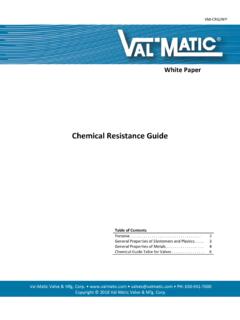Transcription of Materials and their Flow Properties
1 Materials and their Flow Properties 1. Polymers and Plastics 2. 2. Thermopalstic Materials 7. 3. Viscosity and Viscosity Terms 13. 4. Flow Properties Measurement 16. 5. Elastic Effects in Polymer Melts 19. 6. Die Swell 19. 7. Melt Fracture 21. 8. Sharkskin 22. 9. Frozen-In Orientation 23. 10. Draw Down 24. 38 Forge Parkway | Franklin, MA 02038 USA | Tel: +1 (508) 541-9400 | Fax: +1 (508) 541-6206. - 1- Polymers and Plastics A polymer is a chemical compound made up of a large number of identical molecular repeating units.
2 A plastic material is a polymer, generally modified with additives, which is capable of being shaped or molded under reasonable conditions of temperature and pressure. It generally is solid at room temperature and is distinguished from a rubber/elastomer by having a higher stiffness/modulus and a lack of reversible elasticity. A thermoplastic is a plastic material that will soften (melt) on heating and harden on cooling. This softening (or melting) by heat and hardening by cooling can be repeated. This allows thermoplastic Materials to be recycled.
3 Synthetic Polymers Most commercial polymers and rubbers/elastomers are composed of molecules based on the element carbon; that is to say, they are organic. They are synthesized, or made, from simple, oil-based raw Materials called monomers. A process, known as polymerization, connects these simple low molecular weight Materials together to form polymers, which consist of long chains containing many identical repeat units. Polymers and rubbers based on one monomer are known as homopolymers , while those based on two (or more) monomers and are known as copolymers'.
4 They may be linear, branched or cross-linked ( , two or more polymer chains are connected). Usually, polymer chains of a wide range of lengths (chains of varying molecular weight) are present in commercial Materials . Since the final molecular weight (and size) is generally large, these Materials are frequently referred to as high polymers or macromolecules . Although a high molecular weight is necessary to obtain useful Properties (such as stiffness and strength) in a plastic material, it also means that the material is difficult to process.
5 All plastics are polymers but not all polymers are plastics. Cellulose, for example, is a polymer, but it cannot be processed like a plastic material unless it is modified. Long Chain Structure The high polymer molecules , or macromolecules , that are used in plastics are incredibly long. There may be, for example, 50,000 atoms linked together in a long chain-like molecule or structure. Because of the structure of the carbon to carbon bond on which they are based, they generally are not straight, but are twisted or coiled.
6 As a result of the nature of the polymerization reactions, the chains also have a distribution of different lengths. When there is no order in the system (an amorphous material), the chains prefer to exist in a random, coiled-up state (just like the shape obtained when a piece of string is dropped on the floor). The separate long chain molecules (or chains ) are also normally intertwined one with the other. If crystallization of the polymer is possible, then the chains, or portions of the chains, may either fold back on themselves or lie side-by-side in a more ordered fashion.
7 The great length of the chains and the entanglements between them prevent thermoplastic Materials from crystallizing completely on cooling. This is why they are called semi-crystalline thermoplastics . Such Materials contain both crystalline and amorphous regions. 38 Forge Parkway | Franklin, MA 02038 USA | Tel: +1 (508) 541-9400 | Fax: +1 (508) 541-6206. - 2- Amorphous Thermoplastics Thermoplastic Materials may be divided into amorphous Materials and semicrystalline Materials . An amorphous thermoplastic is usually a glassy, hard material that, in the unfilled state, is transparent and rigid.
8 This type of plastic material does not have a sharp melting point, but softens to a melt over a broad range of temperature. It, therefore, can be molded or processed over a comparatively wide temperature range. A major advantage of amorphous polymers is their low and consistent shrinkage, relative to that of semi-crystalline Materials . As the natural color of an amorphous material is generally a clear, water-white, a very wide range of transparent or opaque colors may be produced. Typical amorphous polymers include polystyrene (PS), polymethylmethacrylate (PMMA), styrene acrylonitrile (SAN), polycarbonate (PC), polysulfone (PSU or PES) and polyvinyl chloride (PVC).
9 Modified polyphenylene oxide (PPO-M) and acrylonitrile butadiene styrene (ABS), although not usually transparent, are based on amorphous thermoplastic Materials . Some widely used abbreviations for thermoplastic Materials are shown in Tables 1. and 2. Semi-Crystalline Polymer The amount of crystalline material (% crystallinity), in an extrudate made from a polymer that will form crystals, is typically not 100%. Amorphous areas are always present. Thus these Materials are referred to as semi-crystalline.
10 Typical semi-crystalline polymers are polyacetal (POM), polyamides (PA 6 and PA 66), polybutylene terephthalate (PBT), polyethylene terephthalate (PET), low-density polyethylene (LDPE), high-density polyethylene (HDPE), polyphenylene sulfide (PPS), and polypropylene (PP). Semi-crystalline polymers are usually malleable, tough, durable, and have a good chemical resistance. Usually they are not clear because the crystal structures that they contain scatter light. Semi-crystalline polymers may have a sharp melting point or, more usually, a fairly narrow melting point range.












